I’m sure you have seen grown up salamanders, but how do they look when they’re just a newborn? You’ll know if you have a salamander egg. Have you ever wanted to get a glimpse into the fascinating world of salamanders?
Salamander eggs provide an up-close and personal look at these incredible animals that often go unnoticed by pet owners. From the moment they are laid until hatching day, watching salamander eggs grow is a wonderful experience for anyone interested in learning about amphibians.
In this blog post, I’ll discuss what salamander eggs are and other related queries and make you a true salamander egg expert…
Do Salamanders Lay Eggs Or Give Birth?
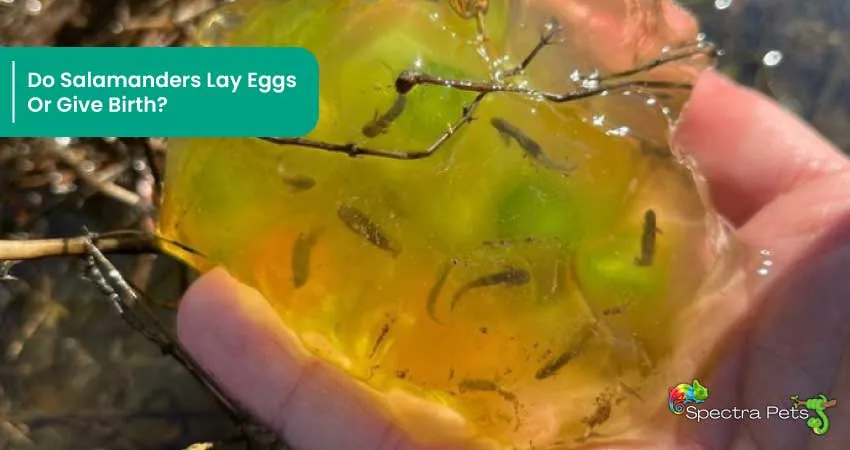
Salamanders are a group of amphibians known for their slender bodies and unique ability to regenerate lost limbs. These fascinating creatures have a lifecycle that begins with the laying of eggs, which hatch into aquatic larvae known as “tadpoles.”
Although most salamanders come to life by hatching from an egg, some species, like the fire salamander and the alpine salamander, give birth directly.
When it’s time to reproduce, female salamanders typically lay their eggs in a moist, protected area, like a pond or stream. The female usually secretes a sticky substance that is used to attach the eggs, which are frequently laid in clusters, to plants or other objects.
At What Stage Of Metamorphosis Can A Salamander Lay Eggs?

As with most other amphibians, salamanders also undergo metamorphosis during their life cycle. Now, you may wonder, in what stage of metamorphosis is a salamander ready to reproduce?
Well, usually, most salamanders reach sexual maturity when they are past their larval stage and have grown into adults. However, there are some species living in harsh environments that gain the ability to reproduce and lay eggs even at the larval stage. Because of the harsh environment, these species have adapted and learned to lay eggs in their larval stage in order to ensure their survival.
What Time Of Year Do Salamanders Lay Eggs?
The exact time of year when salamanders lay eggs can vary depending on the species and the environmental conditions in which they live.
In general, salamanders tend to lay their eggs during the spring or early summer, when the weather is warm and moist. This allows the eggs to develop and hatch into larvae, or “tadpoles,” which will have the best chance of survival. Some species of salamanders may also lay eggs multiple times throughout the year, depending on the availability of food and other factors.
Here is a table that shows the breeding season of a few salamander species:
| Species | Breeding Season |
| Red Salamander | From spring to autumn |
| Tiger Salamander | Spring |
| Marbled Salamander | From late summer to autumn |
| Spotted Salamander | Spring |
| Blue-spotted Salamander | Spring |
| Slender Salamander | Autumn |
| Dusky Salamander | Spring |
| Slimy Salamander | From spring to summer |
| Two-lined Salamander | From autumn to spring |
| Four-toed Salamander | From autumn to spring |
Now, the next question that comes to mind may be, where exactly do salamanders lay their eggs? Let’s learn more about this together, shall we?
Where Do Salamanders Lay Their Eggs?

Salamanders typically lay their eggs in a moist and sheltered location, such as a pond or stream. The eggs are often laid in clusters and are attached to vegetation or other objects using a sticky substance secreted by the female. This helps to protect the eggs and keep them moist, which is important for their survival.
Some species of salamanders may also lay their eggs in other locations, such as under logs or in burrows, depending on their habitat and the conditions in which they live.
What Do Salamander Eggs Look Like?
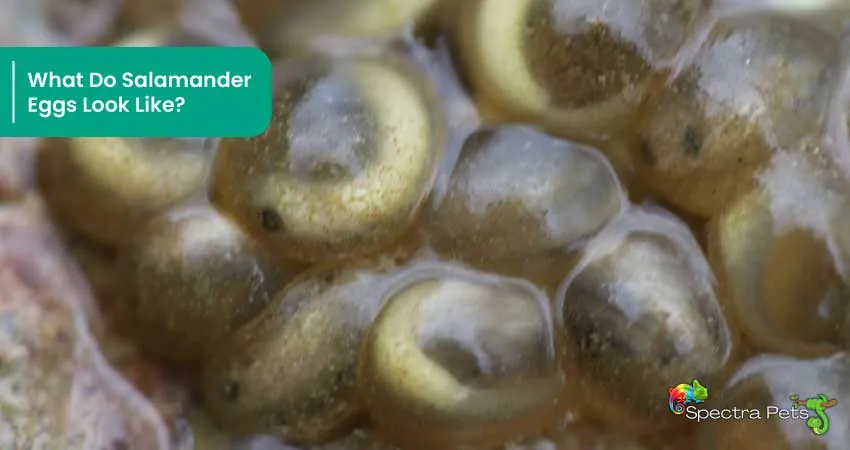
Now, you may wonder what a salamander egg really looks like.
Salamander eggs are small and spherical in shape, and are typically found in strings or chains attached to aquatic plants or other structures. They are usually opaque, so the developing embryo is not visible, and they are typically a pale white or cream color. Depending on the species of salamander, the eggs may be covered in a protective jelly-like substance, which can give them a glossy appearance.
Additionally, some salamander eggs may have small black or dark-colored spots on their surface, which are the pigmented cells of the developing embryo. Overall, salamander eggs are quite small and can be difficult to see without close inspection.
One of the most interesting things about salamander eggs is their ability to withstand drying out. Unlike the eggs of many other amphibians, salamander eggs have a special coating that helps them retain moisture and remain viable even when exposed to air. This adaptation allows salamanders to lay their eggs in a wider range of environments, including areas that may temporarily be out of water.
Do Salamanders Have Amniotic

Amniotic eggs are a type of egg that contains several protective membranes, including the amnion, which surrounds and protects the developing embryo. This allows the embryo to develop and grow in a moist environment, without being damaged by the surrounding environment.
This is important for amphibians, which lay their eggs in water or moist environments, as it allows the developing embryo to breathe and obtain oxygen from the water. The amniotic egg also provides other essential functions, such as waste removal and providing nutrients to the developing embryo.
Overall, the amniotic egg is an important adaptation that has allowed amphibians, including salamanders, to reproduce and thrive in aquatic environments.
Now, to answer the original question: yes, salamanders do indeed have amniotic eggs.
But so do frogs as well! So, how exactly could you tell them apart? Let’s find out in the following section.
How Do You Tell Frog Eggs Apart From Salamander Eggs?

This is a problem a lot of novice amphibian lovers have. They can’t tell frog eggs apart from salamanders. Well, frog and salamander eggs can look similar at first glance, but there are a few key differences that can help you tell them apart.
One of the main differences is the size and shape of the eggs. Frog eggs are usually larger and more oval in shape, while salamander eggs are smaller and more spherical. Frog eggs are also typically more transparent, allowing you to see the developing embryo inside, while salamander eggs are usually more opaque.
Additionally, frog eggs are usually found in clumps or masses, while salamander eggs are typically found in strings or chains.
Finally, the location where the eggs are laid can also be a clue. Frogs typically lay their eggs in water, while salamanders lay their eggs on land or in water.
How Many Eggs Can A Salamander Lay?

The number of eggs that a salamander can lay on one go depends on the species of salamander and the individual salamander.
Generally, salamanders lay varying numbers of eggs and most species lay several dozen to several hundred eggs at a time.
Interestingly, Some salamanders, such as the spotted salamander, can lay up to 500 eggs at a time, while others, such as the red-backed salamander, may lay as few as 10 eggs.
Additionally, the amount of eggs a salamander lays can also vary depending on factors such as the salamander’s age and health, the availability of food and other resources, and environmental conditions.
So, how exactly are salamander eggs fertilized? Let’s find out more on this in the next part. It is truly quite unique!
How Are Salamander Eggs Fertilized?
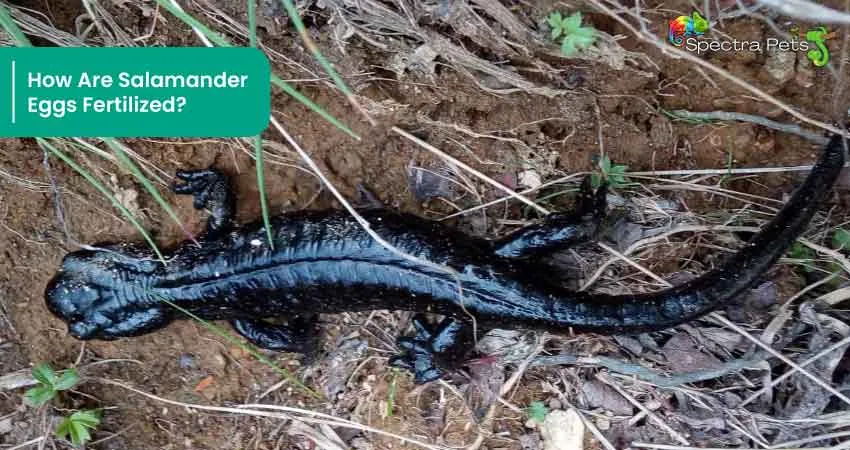
Salamanders, like other amphibians, lay their eggs in water, where they are fertilized externally. This means that the eggs are fertilized by the male salamander after they are laid, rather than before they are laid, as is the case with birds and mammals. During the breeding season, male salamanders release their sperm into the water, where it comes into contact with the eggs that have been laid by the female.
The sperm then fertilizes the eggs, and the embryos begin to develop inside the eggs. In some species of salamander, the male may use his tail or other body parts to help spread the sperm over the eggs, ensuring that they are properly fertilized.
Now let’s see how long salamander eggs take to hatch after they’re fertilized.
How Long Does It Take For A Salamander Egg To Hatch?
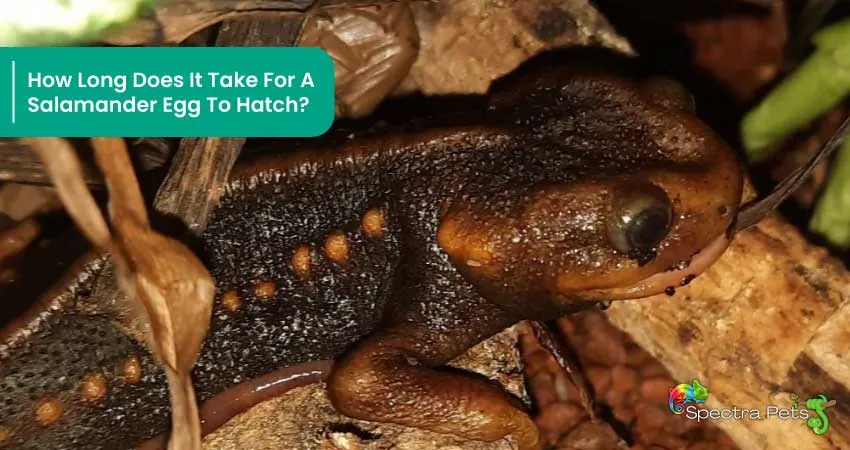
Generally, the length of time it takes for a salamander egg to hatch can vary, but most species hatch within a few weeks to a few months after being laid.
Again, the length of time it takes for a salamander egg to hatch can vary depending on a number of factors, including the species of salamander and the environmental conditions.
In general, salamander eggs hatch within a few weeks to a few months after they are laid, depending on the species. For example, the spotted salamander, which is found in eastern North America, has an incubation period of about 4 to 6 weeks, while the European fire salamander has an incubation period of about 2 to 3 months.
Additionally, the incubation period can be affected by factors such as the temperature and moisture levels of the environment where the eggs are laid. Warmer temperatures and higher levels of moisture can speed up the incubation period, while cooler temperatures and drier conditions can slow it down.
What Do Salamanders Look Like When They Hatch?

Once the eggs have been laid, the baby salamanders will typically hatch within a few weeks, depending on the species and the environmental conditions. Upon hatching, the larvae will begin to feed on small aquatic animals, such as insects and crustaceans. Over time, they will undergo a process known as “metamorphosis,” in which they transform into their adult form, developing legs and losing their gills in the process.
As they grow, salamander larvae will continue to shed their skin and undergo changes in their body shape and size. Eventually, they will reach a point where they are ready to leave the water and begin their adult lives on land. At this stage, they will have fully developed lungs and be able to breathe air, allowing them to explore their surroundings and find food.
The exact appearance of newly hatched salamanders can vary depending on the species of salamander. For example, some species may have gills or other adaptations for living in water, while others may have adaptations for living on land.
Do Salamanders Eat Their Own Eggs?
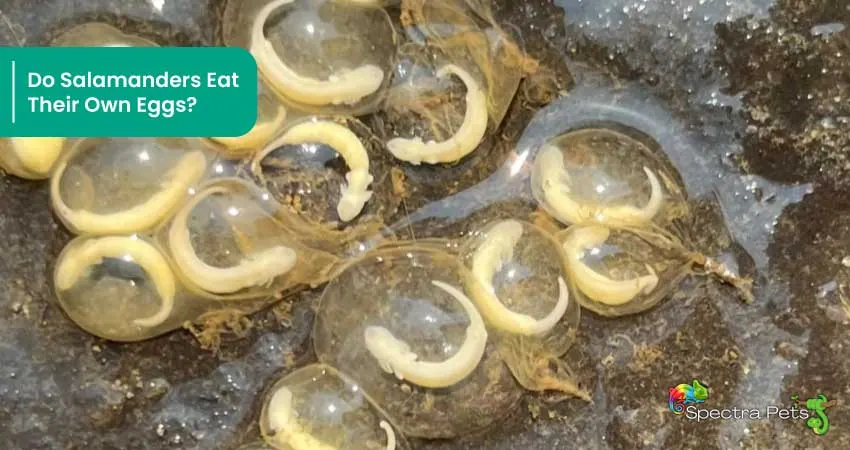
It is not uncommon for salamanders to eat their own eggs, especially if the eggs are not viable or if the salamander is hungry. In some species of salamanders, such as the fire salamander, the female may even eat her own eggs as a way of protecting them from predators. This behavior is known as oophagy, and it is thought to be a way for the female to recover nutrients that were invested in the eggs.
Not all salamanders engage in oophagy, though, and some species are known to be very protective of their eggs. It is also worth noting that salamanders are not the only animals that may eat their own eggs; many species of reptiles, birds, and even some mammals have been known to do so under certain circumstances.
Do Salamander Reproduce Sexually Or Asexually?
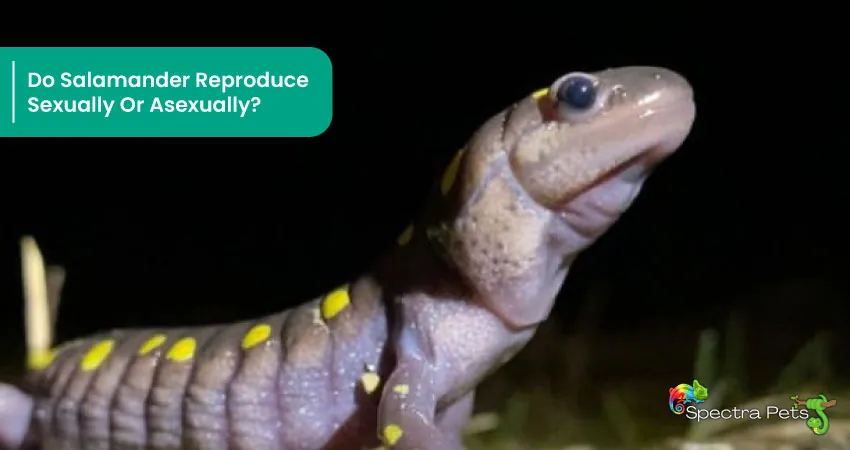
Salamanders reproduce sexually, meaning that they require a male and a female individual to produce offspring. During reproduction, the male and female salamanders will mate, and the female will lay eggs that will be fertilized by the male’s sperm. This process results in the creation of genetically diverse offspring, which can help to ensure the survival of the species.
Some species of salamanders are known to reproduce asexually as well, but this is less common. Asexual reproduction is a process in which an individual is able to produce offspring without the need for a mate. This can occur through processes such as parthenogenesis, in which eggs develop without being fertilized, or through the production of clones.
Now that you know how salamanders reproduce, do you think that salamanders give birth? Or do they lay eggs? Let’s find out.
Frequently Asked Questions(FAQs)
Do Salamanders Lay Eggs In The Dirt?
It is possible for salamanders to lay their eggs in the dirt, although this is not common. Most salamanders lay their eggs in a moist and sheltered location, such as a pond or stream, where the eggs have a better chance of surviving and hatching into larvae.
If a salamander does lay its eggs in the dirt, it is likely to choose a location that is moist and protected from the elements, such as a burrow or a shady spot beneath a log or rock. In general, salamanders are more likely to lay their eggs in water than in dirt.
Do Salamanders Stay With Their Eggs?
Salamanders do not provide parental care to their eggs or young, so once the eggs are laid, the adults will typically move on and continue with their lives. Some species of salamanders may exhibit maternal behavior and remain near their eggs for a brief period of time, but this is not universal among all salamander species.
How Big Are Salamander Eggs?
The size of salamander eggs can vary depending on the species of salamander. In general, salamander eggs are quite small, with most species laying eggs that are less than a centimeter in diameter.
However, some species of salamander, such as the hellbender salamander, can lay eggs that are slightly larger, up to about 1.5 centimeters in diameter. Additionally, the size of the eggs can also vary depending on the individual salamander and its overall health and nutritional status.
What Do Salamander Eggs Need to Survive?
Salamander eggs need a moist environment in order to survive. They also need a suitable substrate to attach to, such as rocks or vegetation. In addition, they need to be protected from predators and other potential threats.
Some species of salamanders lay their eggs in water, while others lay their eggs on land. In either case, the eggs need to be in an environment that provides the necessary conditions for their survival.
Do Salamanders Lay Hard Eggs?
Most salamander eggs are not hard. Instead, they are typically small and translucent, and are surrounded by a jelly-like substance. This helps to protect the eggs and keep them moist.
The eggs are also typically attached to a solid surface or free-floating, rather than being laid in a hard-shelled nest. The exact appearance of the eggs can vary depending on the species of salamander, but in general, they are not hard.
Wrapping Up
Salamander eggs are an important part of the lifecycle of these fascinating amphibians. Many salamander species are on the edge of extinction, and their eggs are a vital part of helping them repopulate. If you find some, it’s important that you report them to the nearest wildlife conservation center so they can be properly cared for.
Once they’ve hatched, the baby salamanders will need to be released into an area with appropriate living conditions for their species. Be sure not to handle the eggs too much, as this can damage them. With a little bit of knowledge and care, we can help ensure that these amazing creatures stick around for many years to come.
